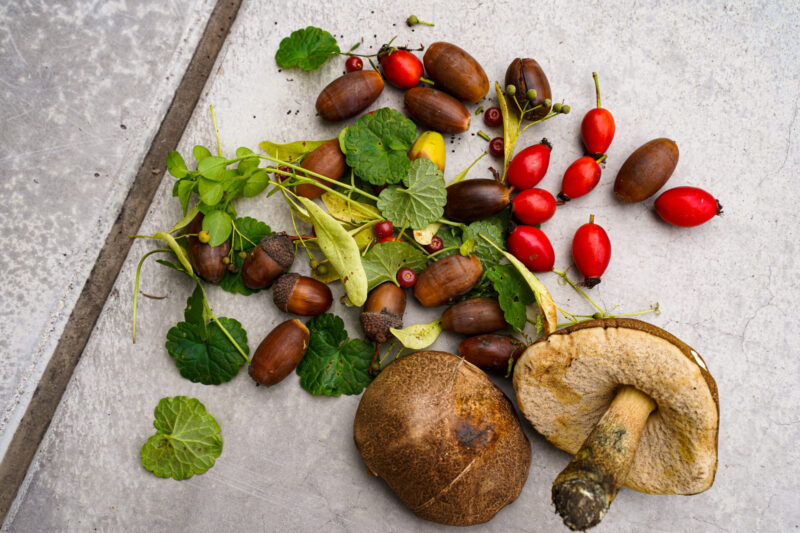You might not think it, but even the Zernike Campus is home to a wealth of edible plants and fruit, even in fall. UKrant went on a walkabout with a foraging guide to find ingredients for such things as tea, bread, and herb butter.
‘Look’, says Sanne Scheltena, kneeling down in the car park behind the Willem-Alexander Sports Centre. ‘This is ground-ivy.’ Scheltena, who once studied biology at the UG and now works as a foraging guide, points to an unassuming little plant. ‘It’s a great replacement for parsley in herb butter.’ Next to the plant are some acorns. ‘You can roast them and grind them into flour. Great for bread.’
The green spaces of the Zernike Campus, like here at the Zernikelaan, are a great place to go foraging, says Scheltena. ‘You need to find those places where they don’t mow very often. That’s where the more interesting herbs and grasses grow, especially in spring and summer.’
During the fall, you’ll find mostly nuts and seeds, such as acorns, hazelnuts, and lime blossom seeds. ‘Those seeds are great in biscuits if you roast them’, she says.
Salads and smoothies
‘If I wanted to forage for all my meals, I’d spend all day looking for food, just like hunter-gatherers used to do’, says Scheltena. ‘That’s impossible.’ That’s why she sticks to looking for things to liven up her meals, such as giant mustard to put in a salad, or chickweed for a green smoothie.
A little while later, we’re standing next to a rose bush next to the Zernike park. ‘Here, have a taste’, says Scheltena. ‘These rose hips are a little hard still, but they’re really sweet and are full of vitamin C. They’re great for jam, but you can also make tea out of them or even put them in soup.’
Normally, Scheltena organises foraging walks at the Hoornsemeer or the Stadspark for groups of approximately ten people. It’s a part-time job; she’s also a coach. ‘I’d go nuts just sitting at a desk all day. I genuinely love being outside. I generally organise the walks starting in spring until late fall, whenever I have some free time. And I love cooking. Foraging brings all my hobbies together. Things I find during the day end up in my evening meal.’
Blog
As a little girl, she’d join her grandmother to forage for herbs and berries. ‘My little sister wasn’t remotely interested, but it stuck with me. I also wrote a blog about edible wild plants.’
In 2015, she got a call from a journalist from Dutch newspaper Dagblad van het Noorden, who’d read her blog. ‘He was impressed with my knowledge of edible plants. We did a tour of the Stadspark together for an article.’ After that, all kinds of people started asking her if she could organise foraging tours. ‘I figured I might as well get paid for it.’
That was seven years ago, and her foraging tours are becoming ever more popular. ‘I’ve noticed that things like zero waste and local foods have become more popular trends over the past three years’, says Scheltena. ‘When I started, I’d mainly get older people on my tours. But recently, I’ve seen younger people and students.’
Poisonous
Near the Zernikeplein, we find some large, brown and grey mushrooms. ‘These are probably boletes, either poplar or birch’, she says, carefully twisting the fungus up out of the ground. ‘These are great in a frying pan. They have a similar structure to the Asian shiitake.’
Even though some plants look a lot like other, poisonous plants, Scheltena has never suffered any ill effects from her foraging. ‘If I don’t recognise a plant, I’ll look it up in my plant guide. Or I’ll take a picture so I can look it up at home. Most importantly: if you’re not sure what it is, don’t eat it.’

Recipe
If you’ve spotted some ground-ivy around Zernike, why not try Sanne’s recipe for home-made herb butter?
INGREDIENTS
100 grams of (organic) butter, room temperature
1 handful of allium, just the leaves and flowers
1 handful of ground-ivy, leaves and flowers
1 handful of cuckoo flowers, just the flowers
1 handful of bittercresses, leaves and flowers
1 pinch of sea salt
1 clove of garlic or ramsons
PREPARATION
Remove the butter from the fridge several hours before you start to let it come up to room temperature.
Pick the edible herbs at a clean spot. Wash the herbs and carefully pat them dry.
Use a knife or scissors to cut the herbs into small strips. Tip: save the flowers as garnish.
Mix the herbs into the softened butter.
Add a squeezed clove of garlic if you like. If you do use garlic, be aware: the garlic flavour in the butter will get stronger over time.
Taste your butter before adding salt. Add a little bit of salt at a time and keep tasting until you’re satisfied with the flavour of your wild herb butter.



